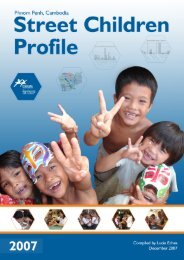Download - Friends International
Download - Friends International
Download - Friends International
Create successful ePaper yourself
Turn your PDF publications into a flip-book with our unique Google optimized e-Paper software.
7.5 percent, Kampong Cham 4.4 percent and Neak Loeung 3.8 percent. The distribution<br />
of questionnaires thus follows similar trends as the snapshot survey, with the majority of<br />
forms completed in Phnom Penh.<br />
General Findings of the Questionnaire Survey 2009<br />
This section, presenting the general findings of the questionnaire survey 2009, aims at<br />
analysing the results that are directly comparable to those of the snapshot survey and<br />
the questionnaire survey of the CSCN profile 2008. The analysis of the general findings<br />
will thus focus on the 3-fold categorisation of street children/youth, male to female ratio<br />
and gender distribution. Methodologically, this serves to cross check the accuracy of the<br />
data of the 2009 survey and observe annual changes.<br />
Total by Category<br />
7%<br />
12%<br />
50%<br />
SLC SWC SLF<br />
Of the total 1,549 questionnaires completed, 50<br />
percent (774) of the street children/youth felt into<br />
the category SWC; 31 percent (472) SLC; and 12<br />
percent (187) SLF. 7 percent did not provide any<br />
information or were categorised as young migrants<br />
31%<br />
or referral NGO. The detailed questionnaire survey<br />
thus points to a similar distribution of categories<br />
as in the questionnaire survey of the CSCN profile<br />
2008 (51 percent SWC; 32 percent SLC; 17<br />
percent SLF). However, there is a much higher<br />
No Info prevalence of SLC than identified in the snapshot<br />
survey (12.2 percent). One explanation for this outcome is the rela-tively higher number<br />
of questionnaires filled out in Phnom Penh (67.5 percent), where the SLC phenomenon<br />
is most prevalent, compared to the children/youth counted in the snapshot survey. Of<br />
the SLF there is statistical consent, meaning that the group of SWC of the questionnaire<br />
survey has decreased in proportion with the growth of the SLC group.<br />
Regarding the gender distribution of the street children/youth population addressed in<br />
the questionnaire survey, 70.8 percent (1096) were male, 29.1 percent (451) female<br />
and only 0.1 percent (1) transsexual. Distributed on each category the male to female<br />
CSCN<br />
30 CSCN Street Children Profile 2009






